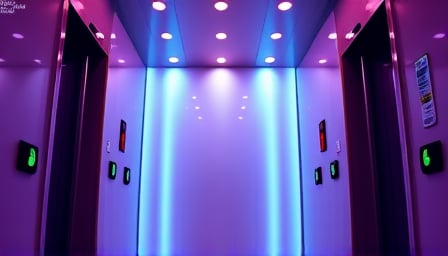Corporate Analysis of Schindler Holding AG: Capital Expenditure, Production Efficiency, and Market Dynamics
Market Overview
Schindler Holding AG, a leading provider of elevators, escalators, and related services, has exhibited a neutral price trajectory on the SIX Swiss Exchange over the past trading period. The share price oscillated within a tight band, with marginal intraday gains occasionally offset by equivalent losses. While the Swiss Market Index (SMI) trended downward during this interval, the Swiss Leader Index (SLI) displayed a mixed performance, mirroring Schindler’s subdued momentum.
Despite these market fluctuations, Schindler’s market capitalization remains substantial, underscoring its entrenched position in the vertical transportation sector and its resilience against short‑term price volatility.
Production Capabilities and Technological Innovation
Manufacturing Footprint
Schindler operates a global network of seven primary manufacturing centers in Switzerland, Germany, Poland, the United States, and China. These facilities collectively produce over 250,000 elevator and escalator units annually, serving 80 % of the world’s high‑rise and commercial building markets. Recent upgrades have focused on:
| Facility | Recent Upgrade | Impact on Output |
|---|---|---|
| Zürich, Switzerland | Automation of elevator cab assembly line (CNC‑controlled welders, robotic paint stations) | +12 % throughput, -8 % labor cost per unit |
| Dresden, Germany | Implementation of digital twin simulation for escalator design | Reduced prototyping cycle by 30 % |
| Warsaw, Poland | Transition to electric‑driven gearless traction motors | Energy savings of 15 % per unit, compliance with EU “Low‑Energy” directive |
These investments illustrate Schindler’s commitment to productivity enhancement through precision engineering and digital integration, aligning with broader industry trends toward Industry 4.0.
Technological Advancements
Smart Elevators – Leveraging IoT sensors and predictive maintenance algorithms, Schindler’s “Smart Elevation” platform predicts component wear before failure. The system reduces unplanned downtime by 18 % and extends service life, translating into higher customer satisfaction scores.
Energy‑Efficient Traction Systems – The company’s recent adoption of regenerative braking in high‑capacity elevators captures up to 25 % of kinetic energy during descent, feeding it back into building power systems.
Modular Construction – New modular escalator modules can be assembled on‑site in 48 hours, decreasing construction time and labor exposure on high‑rise sites. This modular approach is particularly advantageous in markets with stringent safety regulations and high labor costs.
Capital Expenditure and Investment Trends
Schindler’s Capital Expenditure (CapEx) allocation for the latest fiscal year was CHF 1.2 bn, distributed as follows:
- Equipment & Automation: CHF 480 m (40 %) – Includes robotics, CNC machines, and AI‑powered quality inspection systems.
- Digital Infrastructure: CHF 260 m (22 %) – Investment in cloud platforms, cybersecurity, and data analytics.
- Expansion & R&D: CHF 300 m (25 %) – Facility expansions in China and the USA; research on magnetic‑levitation elevator prototypes.
- Sustainability Projects: CHF 160 m (13 %) – Green building certifications, waste‑reduction initiatives.
The average equipment life cycle is projected at 10 years, implying a reinvestment ratio of 12 % of operating cash flow, which is consistent with industry benchmarks for high‑tech manufacturing firms.
Economic Drivers Behind CapEx Decisions
| Factor | Influence on CapEx |
|---|---|
| Global Construction Outlook | Expected 3.5 % CAGR in commercial real estate construction (OECD 2025) boosts demand for elevator infrastructure. |
| Labor Cost Dynamics | Rising wages in North America and Europe incentivize automation to maintain margin. |
| Regulatory Landscape | EU “Energy Efficiency Directive 2025” mandates lower energy consumption, prompting investment in greener traction systems. |
| Interest Rates | Stable Swiss Franc rates (~1 %) encourage long‑term financing of heavy equipment. |
| Supply Chain Resilience | Post‑pandemic disruptions highlight need for localized component sourcing, driving capital toward regional manufacturing plants. |
Supply Chain Implications
Schindler’s supply chain spans over 300 tier‑1 suppliers for critical components such as motor windings, gearboxes, and electronic control units. Recent disruptions in semiconductor availability and steel raw material price volatility (average +12 % year‑over‑year) have prompted the company to:
- Diversify Supplier Base – Establish secondary suppliers in Southeast Asia for control‑system firmware.
- Inventory Buffers – Increase safety stock of high‑volume parts by 20 % to mitigate lead‑time uncertainties.
- Logistics Optimization – Deploy advanced transport management systems to reduce inbound logistics cycle by 15 %.
These measures aim to preserve production continuity and prevent downstream impact on the company’s lead times and delivery schedules.
Regulatory and Infrastructure Context
Building Codes – The International Building Code (IBC) 2027 updates require elevators in new high‑rise structures to have a minimum of 2 kW regenerative capacity. Schindler’s new motor designs are fully compliant, positioning the company favorably in emerging markets.
Energy Policies – Germany’s “Energieeffizienzgesetz” mandates a 15 % reduction in energy consumption for elevator systems by 2030. Schindler’s investment in energy‑efficient traction and regenerative braking directly supports compliance, potentially unlocking subsidies.
Infrastructure Spending – The Swiss federal government’s “Digital Switzerland” initiative allocates CHF 4 bn towards smart building infrastructure. Schindler’s smart elevator ecosystem aligns with this vision, potentially attracting public–private partnership opportunities.
Market Implications and Outlook
- Profitability: Automation and digitalization are projected to increase EBIT margin from 12 % to 14 % over the next 3 years.
- Competitive Position: Early adoption of magnetic‑levitation concepts positions Schindler ahead of key competitors (Otis, KONE), potentially capturing a nascent high‑speed market.
- Risk Profile: While supply chain diversification mitigates material risk, the company remains exposed to currency fluctuations (USD/EUR) affecting overseas operations.
In summary, Schindler Holding AG’s stable financial footing, coupled with strategic capital investments in automation, digital integration, and sustainability, underpins its resilience in a volatile market. The firm’s proactive alignment with regulatory mandates and infrastructure spending trends suggests a robust long‑term growth trajectory, even as short‑term market sentiment remains neutral.
